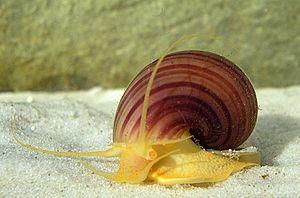Apple snails facts for kids
Quick facts for kids Apple snails |
|
|---|---|
 |
|
| A spike-topped apple snail, Pomacea bridgesii | |
| Scientific classification | |
| Kingdom: | |
| Phylum: | |
| Class: | |
| (unranked): |
clade Caenogastropoda
informal group Architaenioglossa |
| Superfamily: |
Ampullarioidea
|
| Family: |
Ampullariidae
J.E. Gray, 1824
|
| Diversity | |
| 105-170 freshwater species 9 genera more than 150 nominal species |
|
| Synonyms | |
|
Pilidae |
|
Ampullariidae, also known as apple snails, is a group of very large freshwater snails. They are known for being some of the biggest snails around! You can find apple snails in many parts of the world, including Africa, South and Central America, the West Indies, the Southern USA, and Asia.
These snails are great at living in their natural homes. Because of this, they are also popular pets and can be found in most pet stores. People often choose apple snails as pets because of their interesting look and size. They are sometimes called golden mystery snails or just mystery snails. They get the name "apple snail" because one type can grow as big as an apple!
Contents
Where Apple Snails Live
Apple snails live in water. They like water temperatures between 18° and 28° Celsius (65° and 82° Fahrenheit). They eat things like fresh fruits, lettuce, other vegetables, algae, and special food wafers.
Apple snails are common pets in aquariums because of their size. They also seem to prefer living with other snails. They make good pets because they can live in many different water conditions. For example, they can handle water with low or high amounts of oxygen, and various temperatures. However, if the water has a lot of oxygen, they might move a bit slower.
How Apple Snails Are Built
Like other mollusks, snails have a basic body plan. They have a shell, a nervous system, a circulatory system, a respiratory system, and a reproductive system.
Their circulatory system is "open." This means their heart pumps blood, but it doesn't flow through veins and arteries like in humans. Instead, the blood washes over all the organs in the snail's body. The organs then soak up what they need directly.
Their respiratory system includes both gills and lungs. They need gills to breathe underwater. They also have lungs because their bodies have adapted to times when their water might dry up. This way, they can still breathe air during droughts. Their nervous system includes a brain, which helps control their body.
Apple snails are one of the few types of snails that are not hermaphrodites. This means they have separate male and female snails, unlike many snails that have both male and female parts in one body.
What Apple Snails Eat
Apple snails are herbivores, which means they mostly eat plants. In the wild, they eat aquatic plants and algae. When kept as pets, they are often fed fish food. They also enjoy rotting plant material, like soft vegetables.
To eat, apple snails use special teeth called radula teeth to break up their food. Then, they swallow the food, and it goes down to their stomach. After digestion, waste leaves their body as feces. Apple snails eat most aquatic plants. They are also known as scavengers, meaning they help clean up by eating decaying bits in an aquarium.
How Apple Snails Reproduce
Unlike most snails, apple snails are not hermaphrodites. This means there are male snails and female snails.
Male snails produce two types of sperm. One type is used to fertilize the female's eggs. The purpose of the other type of sperm is not yet known.
In female snails, eggs are stored in a part called the "ovaria," which is near their digestive system. The eggs then move to a place where the male's sperm is stored. This is where the eggs get fertilized. After fertilization, the eggs go to a "shell gland." This gland gives the eggs a protective shell. Finally, the eggs leave the mother's body and wait to hatch.
Types of Apple Snails
- Pomacea diffusa, also known as the spike-topped apple snail, Brazilian apple snail, golden mystery snail, and ivory snail.
- Pomacea Canaliculata, known as the channeled apple snail.
Images for kids
-
Pomacea canaliculata eggs.
-
Pomacea canaliculata with its siphon extended.
See also
 In Spanish: Coracol manzana para niños
In Spanish: Coracol manzana para niños



